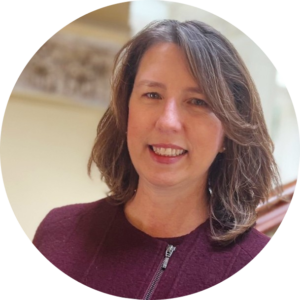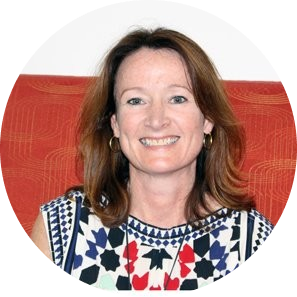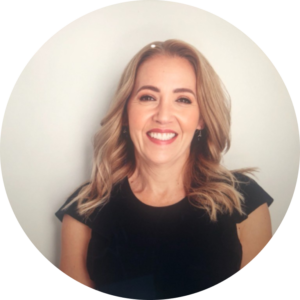Australia has one of the highest breast cancer incidence rates in the world – one in seven Aussie women will be diagnosed with breast cancer during their lifetimes. This equates to an estimated half a million new breast cancer cases in the country over the next 20 years.
Three breast cancer advocates told their unique stories in a recent Volpara webinar to share their views on the need for better personalized approaches to breast cancer screening and risk assessment in Australia:
- Krysty Sullivan, Independent Breast Density Advocate
- Sandy Minck, MD (MBBS, FRACGP), Medical education and communication consultant
- Sarah Powell, CEO, Pink Hope, hereditary cancer advocacy organisation
“I found out about breast density as a risk factor after my cancer diagnosis. If I’d known my density sooner, it could have allowed me to find and treat my cancer 11 months earlier.”
Krysty Sullivan: In 2019 I had unusual breast and back pain on one side, and decided I should get a mammogram. I hadn’t started annual screening because I wasn’t yet 50, but it was easy to access and free. The mammogram came back all clear. Since the mammogram came back negative, my doctor thought there was no cause for concern.
 Then 11 months later, I felt a lump.
Then 11 months later, I felt a lump.
I found a different clinic – a multidisciplinary private hospital – that gave me a mammogram, ultrasound, and a biopsy all in the same day.
The mammogram image did not show any tumours. The ultrasound, however, found two tumours, both over two centimetres. It’s highly unlikely that they weren’t there 11 months earlier.
While sharing my results, my doctor explained that I had highly dense breasts, or BIRADS® D.
I thought that I was breast aware, but I had never even heard of breast density. I still didn’t fully understand what density was, except that it was the reason doctors couldn’t see my tumours on the mammogram. My cancers were essentially snowballs in a blizzard.
Why had I never heard of breast density? Not only does breast density make mammograms harder to read, but it also increases your risk of cancer by four to six times. Maybe I hadn’t heard of breast density because it was a new concept? – but it has been known for decades.
It’s said that women will suffer anxiety if they are told that they have highly dense breasts. There is little discussion around informing women to help us get the care we need.
It felt like a lack of transparency. I trust doctors to inform me about health risks and help me plan how I should try and mitigate those risks in my life. It was very upsetting. If I had known about my breast density and the risk after my first mammogram, I could have sought additional screening the year earlier. If I had understood that I was at increased risk and that a mammogram was ineffective for me, I would have asked for additional imaging.
Understanding your overall breast cancer risk requires being your own advocate
Sandy Minck, MD: I’ve got extremely dense breasts, at the very top percentage of the Volpara density score. I have always had complex, lumpy breasts and there was a point at which I was told I had dense breasts, but even as a former GP, I really wasn’t aware of the significance. 
In terms of risk factors, my mother died of metastatic breast cancer. She was diagnosed at age 57 and died at 69. And I had an aunt on my father’s side who had breast cancer at age 69. Another risk factor I had is that I had my first child very late at age 39, and at 56 I still had not been through menopause, so that long-term oestrogen exposure increased my risk. Finally, I had a microcalcification that was biopsied and showed atypical lobular hyperplasia, which is a benign condition, but can increase your risk of cancer.
In discussion with my breast surgeon, we decided that I’d have genetic testing and an MRI. My MRI showed an abnormality which was suspicious of DCIS. I had a wide local excision that came back with pathology of LCIS, or lobular carcinoma in situ. LCIS is not considered cancer in the same way that DCIS is but is considered by many to be a precursor and does increase your risk up to 10 times.
My risk factors were really starting to add up and I was faced with some decisions. Regular surveillance with alternating MRI and mammograms every six months was recommended. I also decided to start risk-reducing medication.
And that’s what I did until I received the outcome of my genetic testing. My test came back positive for CHEK2, a moderate risk genetic mutation, which led me to the decision to undergo a bilateral risk reducing mastectomy in February 2023. I’m a success story for the importance of knowing all your risk factors.
But while I was planning my surgery, I happened to see a Medical Journal of Australia Insight article titled, “Should we be talking with patients about breast density?” And I thought, “why is this even a question?”
I knew BreastScreen Australia was encouraging public awareness and discussion about breast density, but I did not realize they did not inform women of their breast density, except in Western Australia at that time [now also in South Australia]. How can we make informed decisions when BreastScreen Australia is not giving patients that information?
Breast density continues to be a contentious issue in Australia. I found this statement from the Public Health Association of Australia that talks about the need for women to have accurate information and highlights the issue of over-diagnosis. It states that 10-40% of mammography detected breast cancers will not cause problems in that woman’s lifetime. Overdiagnosis is an issue, particularly in much older women who are potentially more likely to die of heart disease, strokes, etc. However, recent studies show that the overdiagnosis rate which has commonly been quoted at 30% is lower than 10% and might even be as low as 2%.
Other reasons listed as to why women aren’t informed of their breast density included: unnecessary and invasive procedures, additional false positives, and high rates of benign breast biopsies. Every woman I have spoken to has said they would rather have all of that and know their risk than to have a late or delayed breast cancer diagnosis.
Recent studies in Australia found that women don’t suffer anxiety from being notified of their breast density, or if they do it’s a very small percentage of women.
What women do currently is suffer from under the current system is confusion.
Breast density and breast cancer risk resources available to women in Australia
Sarah Powell: We are Australia’s leading patient organisation that supports families with hereditary cancer. These are families that might have known genetic variations or mutations like BRCA, but also includes families that have a very strong family history and haven’t figured out what mutations are happening in their family. At Pink Hope, we support and educate our community on what it means to be at a high risk and their risk-reducing options. As well as being the CEO, I’m also a patient. I was diagnosed with breast cancer 17 years ago when I was 29 years old, without a family history of cancer. 
We recently wanted to understand people’s habits when it comes to self-checking their breasts. Pink Hope did a survey of over a thousand women across Australia and less than half of the respondents said that they were checking their breasts on a regular basis. The biggest reasons were forgetting and not knowing what to do.
A year later, after seeing a study that talked about how women don’t check their breasts because they don’t like their breasts – they’re too big, they’re too small, they’re too saggy after breastfeeding, whatever it is—we did another survey to ask people about body image.
We found that many were not self-checking their breasts because they don’t want to look at their body or touch it.
This shaped our “Know Your Normal” campaign. The program focuses on being comfortable touching your body and knowing what your normal breast tissue feels like, so you’ll know if something is different when you’re doing a self-check. The campaign launches in October 2023 with a goal to get 1000 people signed up for self-check reminders.
These advocates all encourage women to become advocates for their own health and to be unafraid of learning information that may indicate being at higher risk. It is only through information that power over your situation can be gained, enabling actions that can lead to prevention and earlier detection of cancer.
Healthcare providers are invited to access Volpara educational resources to help understand the risks associated with breast density:

